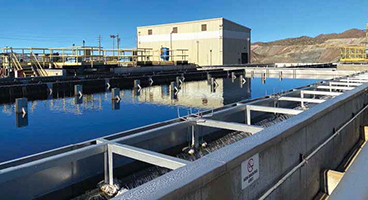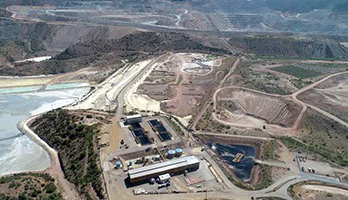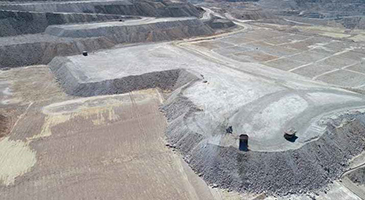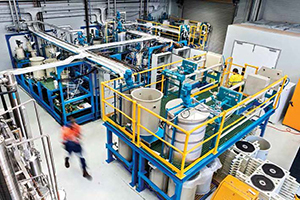
Copper is, by volume, the one metal upon which electrification depends. (Photo: Matthew Henry, Unsplash)
Disruptive Metallurgy for Cleaner,
Greener Battery Metals
How novel hydrometallurgical processes are enabling more efficient and
sustainable extraction of battery metals
By Carly Leonida, European Editor

According to the World Bank Group report, “Minerals for Climate Action: The Mineral Intensity of the Clean Energy Transition,” the production of minerals such as graphite, lithium and cobalt, could increase by nearly 500% by 2050, to meet the growing demand for clean energy technologies.
The group estimates that more than 3 billion tons of minerals and metals will be needed to deploy the wind, solar and geothermal power required for achieving a below 2°C future, as well as energy storage. That’s a colossal figure. One that doesn’t consider the amount of waste material produced using traditional hydrometallurgical and pyrometallurgical extraction methods, nor the emissions generated — carbon, water, heat or otherwise.
While current extraction methods have enabled mining companies to keep pace with demand for metals thus far (hence, their longevity), the step-change required in production as well as environmental performance going forward will require new, more efficient technologies. In turn, those could create opportunities for new business models and streams of revenue.
Jetti Resources: Catalytic
Change in Copper
Hydrometallurgy is typically used for
extracting gold and battery metals like
lithium and cobalt, as well as other minerals.
It is also used predominantly for
copper extraction, where pyrometallurgical
methods are challenged by lower
grades, high energy use and high capital
investment requirements.
Copper, although less exotic than other
metals used in electrification, is by volume
the one metal upon which electrification
depends, due to its conductive properties
and lack of potential substitutes.
Colorado-headquartered technology
company, Jetti Resources, estimates
that 70% of the world’s copper resources
— worth more than $20 trillion — are
tied up in primary sulphide ores, which
are uneconomic to extract using traditional
solvent extraction-electrowinning
(SX-EW) methods.

For copper in particular, the industry faces significant challenges in supplying these minerals in sufficient quantities and in a sustainable manner. Issues such as declining ore grades, mine footprint, emissions and water usage are becoming increasingly acute. “Hydrometallurgy can be instrumental in solving these challenges,” Mora said. “According to Wood Mackenzie, leaching uses three to four times less water and around four times less electricity than pyrometallurgy. The use of leaching technologies also reduces the amount of transport required to move large volumes of concentrate to smelters, which are often in China, and the greenhouse gas (GHG) emissions related to the smelting process.
“Furthermore, when technologies such as Jetti’s are integrated with existing leach systems, waste materials can be transformed into valuable resources, increasing mine life and reducing mine footprint. Hydrometallurgy can help to provide a greater and sustainable supply of battery metals, therefore enabling the transition to an electrified low-carbon economy.”
Previous efforts to solve the sulphide leaching problem have typically focused on using very energy-intensive processes, such as subjecting the ores to high temperatures or crushing them very finely. By doing so, the copper might be extracted rapidly, before the passivation layer forms. However, these processes are expensive and uneconomic at scale. Other alternatives require massive capital investment to prove out a solution.
Jetti’s patented catalysts disrupt the sulphur-metal bonds within the mineral, allowing copper extraction to take place unimpeded. “Our technology was developed through years of research with partners at the University of British Columbia,” Mora explained. “It uses a proprietary catalyst that enhances yields from heap leaching of chalcopyrite. The technology integrates seamlessly with process flow sheets at existing operations, which means utilizing the technology requires low capital and operating expenditure.”
Economic and Environmental
Benefits
When applied to low-grade copper primary
sulphide ores, Jetti’s technology increases
copper extraction by up to 300%
compared to traditional processes, and
because it integrates with existing infrastructure,
the additional costs incurred
are minimal. Jetti can therefore effectively
create a new mine in months rather
than years with low levels of CAPEX
and OPEX and, in an environmentally
responsible manner.
“It is important to recognize that production via the leaching and SX-EW route has been in long-term decline due to declining reserve quality and lower ore grades,” Mora added. “Jetti’s technology can reverse this process by enabling existing SX-EW operations to process ore that was previously too low grade to be processed economically. This has the potential to reinvigorate a number of aging operations while providing an alternative to the development of brownfield concentrate operations.”
While Jetti’s technology does have the potential to be adapted to extract other metals, for now, the company plans to focus only on copper. “Given the versatility of the technology, it has the potential to be used across the copper industry, so the opportunity is already very significant without looking at other metals,” Mora said.
“For example, it can be applied at mines with existing SX-EW plants that have unutilized capacity; operations with historic dumps; greenfield deposits with large amounts of sulphide ore that might be currently uneconomic; and mines with concentrators that are unable to treat all the low-grade material in the deposit.” The potential to use in-situ leaching is mainly dependent upon the nature of the deposit, the natural fracturing density of the host rock in the ground and the presence of a naturally occurring containment layer such as clays. So far, few copper deposits have been found that meet these requirements. However, if those ideal settings are present on a primary sulphide copper deposit, then Jetti’s technology could be adapted for in-situ use, too.
The principal economic benefits of the technology are twofold: first, because it integrates easily with existing SX-EW process flows, it can deliver significant increases in copper yield with minimal upfront CAPEX requirements other than the installation of an on-site catalyst addition facility — there is no grinding or heating required (in contrast to pyrometallurgy). The increased copper yield results in lower unit costs of production. “Second, because it enables the exploitation of low-grade ores, it results in mine lives being extended through the conversion of resources into reserves by converting waste streams and uneconomic deposits into valuable assets,” Mora said.

Additionally, using hydrometallurgical processes also requires less power and transportation than pyrometallurgy, meaning 40% less CO2, 70% less SOx and 70% NOx associated emissions are generated. Finally, because Jetti’s technology enables operators to make better use of existing resources, it reduces the need to disturb untouched ground or to develop new mines, which are increasingly found in environmentally sensitive or water stressed areas.
Clareo Thinks Outside of the Box
Growth strategy specialist, Clareo, has
been working with a number of companies
including miners and technology developers to reimagine leaching applications
for battery metals. Partner, Satish
Rao, joined E&MJ to talk about technologies
and concepts that could improve the
horizons in copper production.
“Given the importance of battery metals and the enormous demand that everybody’s foreseeing over the next couple of decades… Ore grades are already low, they’re going to get even lower,” he said. “The question is, can you go after battery metals, which the world is shifting toward because of ESG concerns, with wasteful processes? “Of course not. The accounting at the end user will eventually drive back to how the metals were extracted. You have to go with the most sustainable approach and that will translate into the economics as well.”

“In leaching, project economics are often constrained by recovery times. The leaching process is also extremely ineffi- cient. In the future, 50%-60% recoveries over a one- to two-year timeframe won’t be good enough. We need to get recoveries to 70%, 80% or even 90%. If we can do that then the opportunity is immense.” While there have been advances in recent years in mobile conveyor technologies, better irrigation systems etc., the heap leach process has remained fundamentally unchanged. It is still dependent upon gravity to coax the lixiviant through the crushed material.
“If we look at new technologies, there are a lot of possibilities in nanotechnology, artificial intelligence, new materials, biotechnology... Initially, you think, what do they have to do with leaching? But, when combined with IoT-enabled sensors, they could really change the paradigm in conventional leaching applications,” Rao said.
There are a number of ways that new technology can be incorporated into leaching. For example, a key challenge with heaps are “dead zones” — areas that do not get irrigated properly or receive inconsistent flow. This impedes or prevents the chemical reaction from taking place. “That’s where you could bring in sensors to monitor the flow,” Rao said. “There are some increasingly low-cost approaches to understanding what’s actually happening below the surface. And, if you’re in a position to measure flow, temperatures and chemical reactions throughout the heap, then you could mine much smarter.”
Nanotechnology,
Electromagnetics and More…
Rao and his team are currently advising
a company called Moleaer, which
started out in the water treatment and
agriculture sectors, applying nanotechnology
to deliver better oxygenation in
water irrigation systems.
“They’ve created nanobubbles that
can be filled with various gases,” Rao explained.
“And they behave differently to
larger bubbles. With larger bubbles, because
the air is lighter than water, they
would float up to the top and pop. But
nanobubbles tend to stay in a suspended
state, which means that you could
oxygenate the aqueous environment for a
long duration without losing gas to the air.
“Those nanobubbles could potentially
be used to oxygenate heap leach environments,
too.”
Clareo has been exploring ways to apply artificial intelligence, and rapid simulation and testing capabilities developed in the pharmaceutical industry to optimize lixiviant chemistries for leaching. Biotechnology also holds much promise. While bio-based leaching has been around for a while, synthetic biology is pushing the boundaries in this field and, again, the ability to simulate the effects of different microbes at different scales quickly and accurately could be a game changer. “If we can bring better computing power and more simulation into the field of bio-based leaching, I think that’s where the next level of breakthroughs might come through,” Rao said. “Companies like Cemvita Factory are starting to do that.”
The team at Clareo is also investigating some non-conventional ways to optimize leaching. For example, using electromagnetics or microwaves to pre-treat ore and improve the reaction rates. “By and large, the industry is still focused on conventional ways to enhance leaching, and there’s a lot to improve there. But what if we bring other disciplines into the mix?” wondered Rao. “Whether it’s pre-treatment during agglomeration, or other areas before you get into an aqueous-based process.”
In-situ leaching, while not new, could also offer possibilities when combined with new recovery technologies. “With in-situ leaching, you don’t have to build a processing facility so there’s a lower capital intensity, and possibly a shorter time to production and improved safety,” Rao said. “There’s a lot of benefits beyond ESG. “However, when leaching in situ, you still have to figure out the right preconditioning approach. If you can’t do the traditional things like agglomeration, perhaps you could impart energy using vibrations, sound, lasers or microwaves. Or maybe you could use bacteria to weather the rock.

Lepidico: Upping the ESG Stakes in Lithium
Of course, copper is not the only “battery
metal” that is ripe for recovery improvements
through hydrometallurgy.
Until 10 years ago, the lithium industry
was primarily characterized by one hardrock
mine — Greenbushes in Western
Australia — and a number of large brine
operations in South America. The market
showed mid-low single-digit growth per
year, and there wasn’t much incentive to
bring new capacity online.
However, the advent of lithium-ion batteries changed everything, and demand for lithium hydroxide in particular as a product for lithium-ion battery cathodes (versus lithium carbonate) has grown hugely over the past five years with no signs of stopping. Lithium mica and phosphates have largely been overlooked by the industry as sources of lithium hydroxide, until recently. However, lithium mica minerals including lepidolite and zinnwaldite are polymetallic and recovery can now be configured to create multiple product streams. This approach allows miners to diversify their business models and reduce their exposure to market risk.
Exploration and development company, Lepidico, has developed a suite of novel processes, including L-MAX and LOH-MAX to enable efficient, economic production of lithium from these minerals. The company is the brainchild of its chairman Gary Johnson. During the 1990s and 2000s, Johnson worked with LionOre and Norilsk before setting up his own metallurgical consulting practice, Strategic Metallurgy. “The team had been doing some work on mica minerals trying to produce sulphate of potash (SOP) fertilizer. It was a technical success but an economic failure,” Joe Walsh, Lepidico’s managing director, said. “There just wasn’t enough value in the SOP to support the process. But it got the Strategic Metallurgy team thinking that there are mica minerals that contain other elements that intuitively have more value. For example, lepidolite, which also contains lithium, cesium and rubidium.”
The team obtained a specimen of lepidolite, ground and leached it and managed to efficiently get the contained metals into solution. In 2014, after further development and several phases of seed capital, they had the bare bones of the L-MAX process and lodged a patent application. By 2015, the team had run their first continuous mini-plant trial in the lab. Walsh joined as managing director in 2016, put together a five-year strategic plan for the business and built a team with the objective of commercializing the technology.
“Nearly five years on, our strategy has not changed,” he said. “The timing of a few things has pushed out as invariably happens in the mining space, particularly after a two-and-a-half-year bear market in lithium. But the strategy is very much the same, it’s still centered around commercialization of the L-MAX process.” Lepidico remains closely aligned with Strategic Metallurgy and, in 2017-2018, as interest began to grow in lithium hydroxide as a product for lithium-ion battery cathodes, the team began to look at adapting L-MAX accordingly.
“In a risk-review, we had identified that at the backend of L-MAX, where lithium sulphate is converted to lithium carbonate using industry standard process steps, there was a potential flaw,” Walsh said. “The conventional process is to use sodium carbonate to produce lithium carbonate, as well as byproduct sodium sulphate. “While we had identified a purchaser for our sodium sulphate, we weren’t convinced that, over the project life, there would a market for this product. Sodium sulphate is a mature market globally, with the main uses being in powdered detergents and in pulp and paper manufacturing. “So, we challenged the team at Strategic Metallurgy to develop a new process to convert a lithium sulphate intermediate directly to lithium hydroxide without production of potentially problematic sodium sulphate, and that’s how the LOHMAX process came about.”
The patent for LOH-Max was lodged in 2019 and Lepidico integrated it into the development plan for its Phase 1 project. Both L-MAX and LOH-MAX have now been successfully piloted. “One of the things that Lepidico has been very keen to do is base it’s process technologies on a reagent regime which is ubiquitous in the industry,” Walsh said. “In leaching, the go-to acid is concentrated sulphuric acid. It’s widely available and affordable versus other acids. And, when it comes to neutralization, the go-to reagents are either limestone or lime.”

“We are very mindful of our environmental and social credentials and responsibilities. Really, the only emissions are some CO2 and low-grade steam. And, if you compare our processes to the rest of the industry, we’re right at the clean end of the spectrum, even on the CO2 basis. We have identified areas for improvement and will certainly be looking at opportunities to get our emissions down to zero in the future.”
Creating a Profitable, Circular Process
How do L-MAX and LOH-MAX work?
“A lithium mica and/or phosphate
concentrate is fed to the front end of the
L-MAX process,” Walsh explained. “It
starts off with a concentrated sulphuric
acid leach. With many other lithium processes,
a lot of effort goes into minimizing
the sulphuric acid addition. We’re
less sensitive to acid usage because we
want to get all of the elements — lithium,
cesium, rubidium and aluminum
into solution, as we can derive value from
most of these, whereas most other processes
don’t benefit from byproducts. We
consume about a ton of acid for every
ton of concentrate we produce. All of the
metals go into solution in a highly effi-
cient manner, with extraction rates of well
over 90% after 18 hours.”
In fact, there are parts of the plant where Lepidico is looking to implement heat capture technology to minimize heat waste. Ultimately, the company is looking to build its own sulphuric acid plant and generate power as a byproduct, but that’s a story for another article… “The residue from the sulphuric acid leach is a highly reactive amorphous silica, which is an effective supplementary cementitious material,” Walsh said. “By partly substituting cement in concrete, it can lower the CO2 footprint of the concrete and it also improves its compressive strength. This is the first byproduct from the process.
“We then cool and filter the leach liquor to remove the first precipitate. The liquor then goes through a series of neutralization steps, which allows various impurities to be selectively removed. To do that, we use lime or limestone. The pH ranges at which the impurities precipitate out are quite broad, so we don’t need to finesse the pH too carefully. It’s a userfriendly process in that regard.” There is some reasonably elegant chemistry involved to selectively remove the cesium, rubidium and potassium as one residue stream while leaving the lithium in solution.
“The lithium stays in solution right the way through the process creating an alkaline liquor and eventually lithium sulphate,” Walsh said. “This is when the LOH-MAX process comes into play. LOHMAX actually uses aluminum hydroxide rather than sodium-based compounds employed in conventional processes. And because there’s aluminum in the system already, we’re not introducing a new impurity into the process.”
LOH-MAX is less energy-intensive than conventional lithium sulphide to hydroxide conversion processes because it only requires a single crystallization step and there’s no requirement for a chiller. These features along with the addition of a recycle stream means it can also offer a four-percentage point improvement in recovery. “Compared to a typical 20,000-mt/y spodumene conversion plant, the CAPEX saving is estimated at around $50 million, the operating cost improvements are about US$8 million a year,” Walsh said. “When you package all of that up, the NPV benefit of LOH-MAX is well over $100 million over a 10-year operating life for a nominal 20,000-mt/y output spodumene converter.”
Lepidico has another patented but, yet unnamed, process that allows it to separate out potassium, cesium and rubidium from one of the L-MAX residue streams. “Our main products are lithium hydroxide, cesium sulphate, rubidium sulphite and SOP fertilizer (potassium); those are all on the U.S. state department’s list of 35 critical minerals,” Walsh said. “I think this is the only process technology that addresses four of the 35 critical minerals. And then we get the additional benefits of the amorphous silica as well.”
Cesium and rubidium are relatively small, opaque markets. Historically, the main source of cesium is a mineral called pollucite. Most of the worlds pollucite reserves are now depleted, and so that brings the focus to lepidolite as the next logical mineral source of cesium, and it also contains rubidium. “We’ll be bringing to market the world’s first-ever commercial source of rubidium,” Walsh said. “And rubidium sulphite can be used in many applications as a substitute for cesium sulphate.” With five potential product streams there can’t be much waste from the process…? “Through the neutralization stages, we’re putting limestone or lime into the system, meaning that much of the residue that reports out is gypsum,” Walsh said. “We’re looking at building our Phase 1 Plant, which is really proof of commercialization, in Abu Dhabi and it’s scaled for that purpose. The UAE imports mineral gypsum, and we’ll be producing a locally manufactured source of synthetic gypsum.”
The remaining residue is a mixture of gypsum and allunites and Lepidico has been working with the University of Waterloo in Ontario to evaluate the use of this residue material from the Phase 1 plant to rehabilitate landfill sites. “One of the opportunities we see is to have a chemical process with only products and effectively zero waste,” Walsh said. Aside from the economic benefits, a zero-waste process is a significant step toward creating circular business models; something the mining industry needs more of going forward.

From the UAE to the UK
Lepidico has completed a definitive feasibility
study for the vertically integrated
Phase 1 project, which requires the re-development
of two open pits at the Karibib
mine in Namibia, along with building a
new small-scale flotation plant to produce
the lepidolite-amblygonite concentrate
that will be exported to Abu Dhabi to feed
the Phase 1 Project’s L-MAX chemical
conversion plant.
“Abu Dhabi is the world largest producer of sulphur, so there’s an abundant, affordable source of sulphur, which we can use to manufacture sulphuric acid,” Walsh said. “There are also markets for our bulk byproducts; the Middle East imports about 100,000 mt/y of SOP fertilizer largely from Chile. “We’ll produce about 12,000 mt/y of SOP and be the only local producer. There’s also a market in construction for amorphous silica. It’s a strategic location that will allow us to minimize our costs and maximize our revenue, and that more than offsets the cost of transporting the concentrate from Namibia to Abu Dhabi.”
Part of the UAE’s 2030 vision is to move its economy away from reliance on oil and gas and introduce new industries, which will now include producing lithium for use in electric vehicles. “We’ve completed the definitive feasibility study, and the three main workstreams to transition the vertically integrated project to development are: permits and approvals, product offtakes and finance,” Walsh said. Lepidico is looking at commissioning in Namibia in the second half of 2022, with production in the latter part of the year. The Phase 1 chemical plant in Abu Dhabi is set for commissioning in the first half of 2023.
And, as if that wasn’t enough, the company also announced a collaboration with Cornish Lithium in December 2020. “We see ourselves as being an enabler, collaborating with industry,” Walsh said. “And that’s exactly what we’re doing with Cornish Lithium in the U.K. They’ve purchased the first license for our technology suite, which includes a royalty-free period. “They can assist in broadening out the application of our technologies into the wider lithium mica mineral suite and demonstrate commercial viability on minerals that include zinnwaldite and polylithionite. In return, the technology gives Cornish Lithium a huge shot in the arm. It’s taken us eight years to get to this point of technological development. They can now go straight into piloting. They purchased not just the license, but also the design pack for our pilot plant too, which should really enable them to fast track their project.
“We’ll support them where we can, and the team at Strategic Metallurgy is supporting them as well,” Walsh added. “I think it’s a fabulous outcome for the industry, that there are green credentialed projects in the southwest of England and the UAE that could produce the first commercial quantities of lithium for both these countries.”